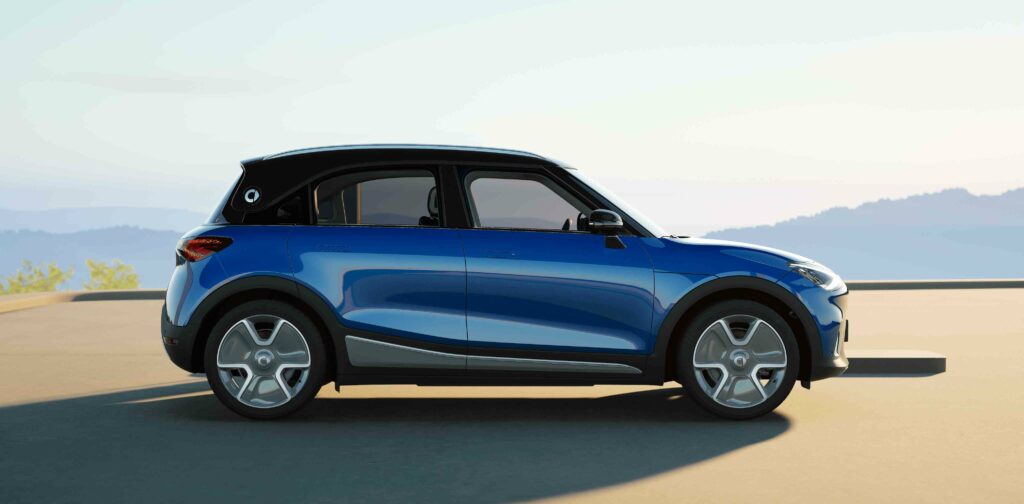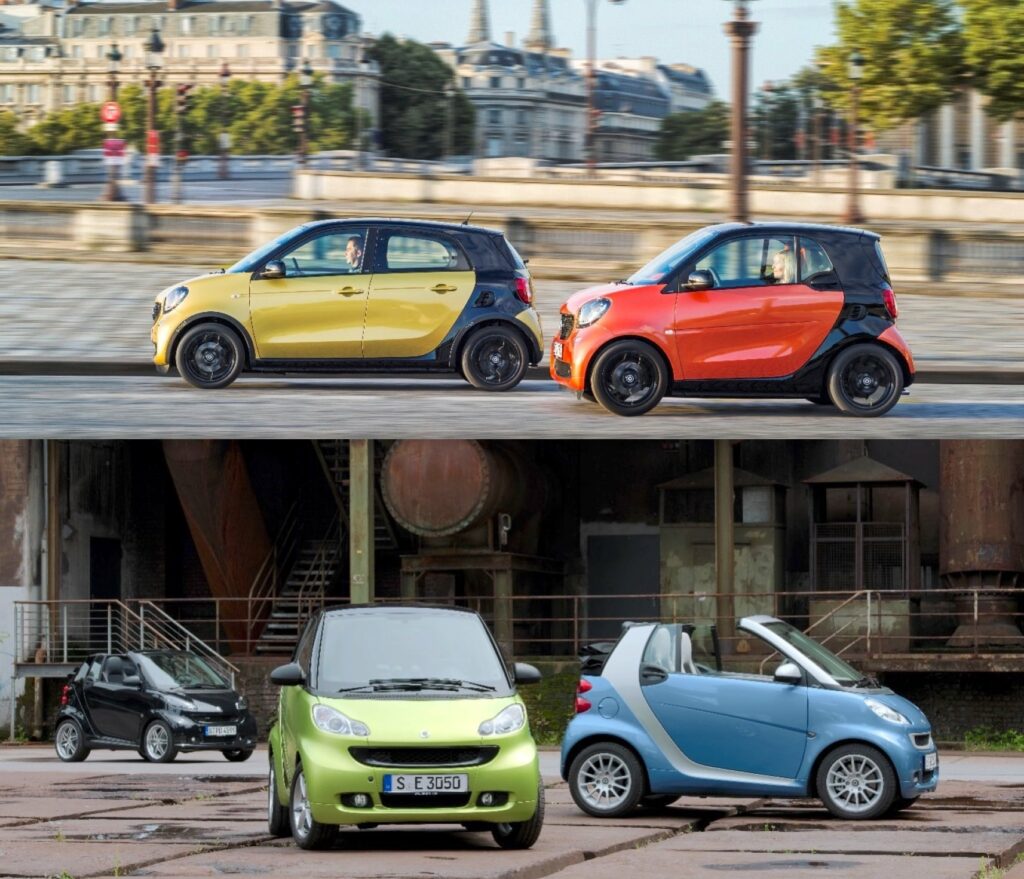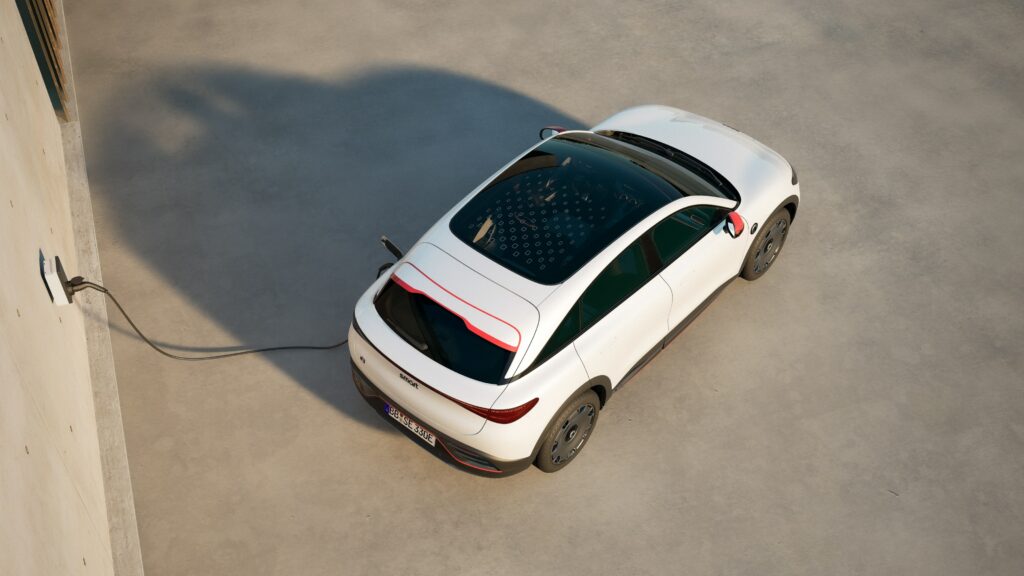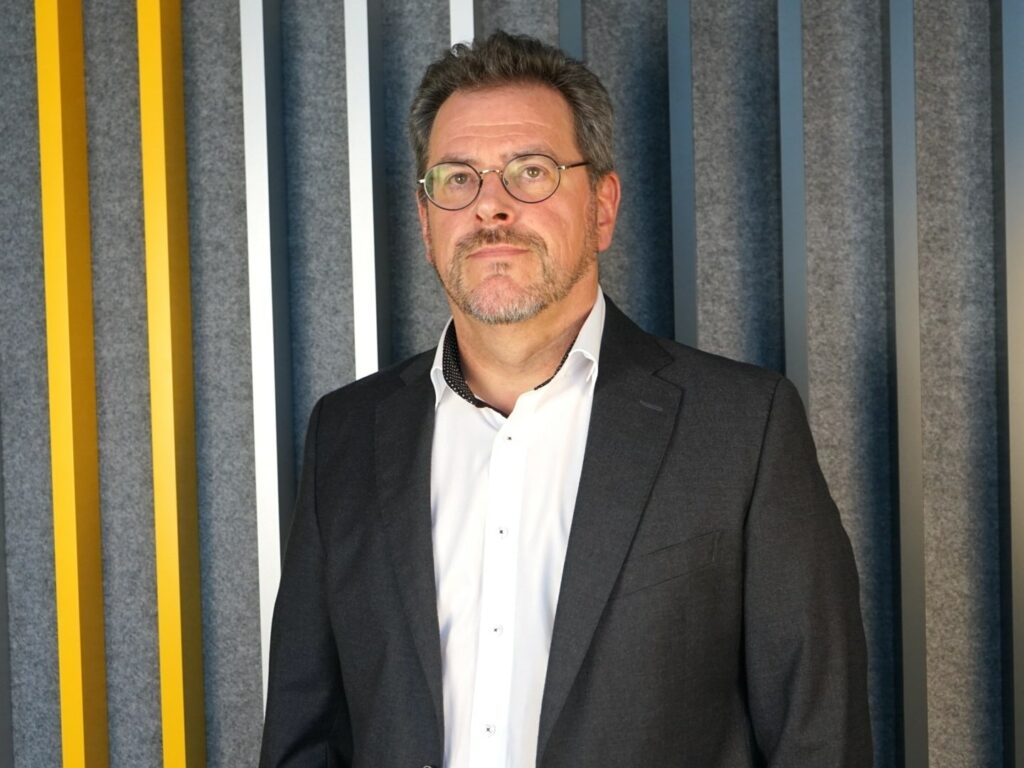In conversation with Dr Tilo Schweers

(Images courtesy of smart)
Smart thinking
smart Europe’s vice-president of r&d shares some of his insights into developing the company’s distinctive battery EVs. By Rory Jackson
While automotive OEMs might now agree that electric powertrains are effectively the future of all mobility, it should be remembered that only 20 years ago, many of them saw electrifying vehicles as a peculiarity at best, and a waste of resources at worst.
So, by the early 2000s, very few had ventured into e-mobility. Matters weren’t helped by General Motors’ now-infamous recall of its EV1, the company citing insufficient profitability despite widespread consumer enthusiasm for the car.
While most OEMs had little interest in pursuing all-electric vehicles following the GM debacle, one company went against the tide to give the world its first and then biggest success story in EVs – the smart EQ Fortwo, better known by its colloquial name, the smart.
Dr Tilo Schweers not only bore witness to that car’s development, but personally led the creation of the smart electric drive programme, as the company’s head of homologation (road approval), technical documentation and special vehicle engineering for the smart’s EV and HEV programmes. That programme led to the company’s first all-electric powertrain vehicle, from the smart EQ Fortwo EV’s first trial through to volume production beginning in 2009.
Although he worked outside smart and the Mercedes family in the late 2010s, these days his career has led him back to smart, where he is vice-president of r&d of smart Europe and leads the company’s EV design, manufacturing and certification activities in Europe and China.
Surprisingly, Dr Schweers’ academic background focused little on automotive electric power systems. “Keep in mind this was in the 1980s and ’90s, so we had different topics on our agenda back then,” he says.
“But there were two main ones that influenced me back then, which I’ve carried with me ever since. One was motorbike research – for which I gave a regular lecture at RWTH Aachen University on motorbike technology and engineering – and the other was a deep involvement in the first stages of what would become electronic stability control [ESC] technology, long before it became a standard offering in passenger cars.”
Particularly important to the foundations of ESC (sometimes better known as ESP or electronic stability program, as branded and popularised by Bosch) was his creation of evaluation criteria for judging the impacts of such systems in passenger cars; notably this was a few years before recognition and standardisation of relevant criteria such as the Moose Test for evasive manoeuvring. Schweers’ research, publications, and ultimately his PhD, laid much of the crucial groundwork for ESC to become mainstream.

Making the smart car
In 1996, while considering moving from technical research and academia into practical, applied engineering in the commercial world, Dr Schweers was approached by MCC (Micro Compact Car), which had recently been founded as a joint venture between Mercedes-Benz and SMH (makers of the Swatch brand of watches) to cater for drivers who wanted small, stylish city cars manufactured and personalised similarly to Swatch watches.
“Right away, I started working on packaging and concept design, but after 6 months I was put into a programme to create the company’s first hybrid powertrain, intended for the first-generation smart car,” he recounts.
‘smart’ was chosen as the name of the marque, a combination of the Swatch name plus Mercedes and art (Swatch Mercedes ART).
“We didn’t know exactly which direction to go in, but it soon became obvious that humanity could not go on forever just burning fuel and not thinking about the consequences. So after MCC became a 100% Mercedes-owned company, and was officially rebranded as smart GmbH, we created a parallel-hybrid powertrain, which at the time was one of the most fuel-economic cars with potential for homologation,” he says.
“Its fuel consumption was 2.7 litres/100 km by NEDC test standards, 0.2 litres/100 km less than the next-best competitor, but that powertrain didn’t make it into production for economic reasons.”
One of its primary takeaways from the r&d led by Dr Schweers had been that electric motors could provide great speed, efficiency and comfort in small city cars. The other was a deep insight into battery technology.
“Battery EVs were less complex than HEVs, and more affordable technologically, meaning on balance a better chance of achieving business success,” he says. “In fact, the biggest challenge wasn’t an engineering one, but convincing the company to let us make one.”
To create momentum for a mass-produced battery EV, Dr Schweers and his colleagues gained Mercedes’ approval to build and supply 100 cars to test customers in London, where a congestion charge had just been enforced.
“That test allowed us to build these cars from converted smart Fortwos [which were originally powered by inline three-cylinder engines], then called the smart Fortwo electric drive, and the automotive world woke up. BMW started working on the MINI Electric, for instance, and once we were satisfied with the first 100, we set our eyes on the next 2000 cars,” he notes.
The second-generation electric smart Fortwo benefited from the advent of Tesla and its Gen 2 lithium-ion battery with its 16.5 kWh of energy and 18650 cylindrical cells, as well as a growing realisation across Mercedes/Daimler that there might be a future in all-electric mobility, enabling them to be built as original EVs rather than converted IC-engined vehicles.
Three more generations of smart EVs followed, each adding energy density, range, power and other benefits from advances across the electric powertrain, particularly in permanent magnet motors and in HVAC systems. Dr Schweers comments that the latter’s HV compressors for air conditioning and PTC heaters for winter might seem like little things, but were critical for making EVs comfortable and acceptable to a wider audience.
“And during the fourth generation, smart decided it would only produce battery EVs going forwards, meaning smart is now the only OEM that converted 100% from IC engines to all-electric,” Dr Schweers remarks.

From Bremen to Beijing
Following some other projects within Mercedes, he was asked by the German car manufacturer Borgward to join as an executive director of r&d for passenger cars.
“I’d grown up 500 m from where Borgward had been originally founded, in Bremen, so it was a name I’d regarded well since childhood,” he says. “On top of that though, and unlike my work at Mercedes, Borgward enabled me to learn about China’s companies, culture and people, and how their fast-rising automotive industry worked. What I learned still serves me hugely, given smart’s re-emergence as a joint European-Chinese venture.”
In 2020, Dr Schweers returned to smart, after the company became a joint venture between Mercedes-Benz and Geely Automobile.
“The primary activities of my team in Europe include automotive testing, verifying that our cars are suitable for European roads, homologation of the cars, technical compliance and so on. But it also covers a lot of other testing activities in the EU and China.

The smart Automobile company
With the greater maturity and range of technologies available for EV manufacturing, smart’s approach to automotive development now differs notably to that from Dr Schweers’ 20 years with smart and Mercedes respectively.
“The big benefit from the Mercedes-Benz/Geely joint venture is that we can now design and create vehicles based on large-scale plant manufacturing,” Schweers says. “The two cars we are producing now, the smart #1 and #3, are manufactured in a factory that builds cars for various brands, allowing much greater output volumes than the old smart could manage.
“Also unique for us is the Mercedes-Benz design. The new product generation of smart is designed by Mercedes personnel in Stuttgart, to carry on the design language of the Fortwo in a new shape and aesthetic but one consistent with the idea that these will still be economical, right-sized city cars, starting with the smart #1.”
The smart #1 was unveiled in April 2022 and is an all-electric compact SUV with a 66 kWh NMC battery pack and a single, 200 kW central-drive permanent magnet AC motor running through a single-speed transmission. The pack gives the 1.8 t vehicle a range of up to 440 km (270 miles) between charges according to WLTP standards, with 150 kW fast DC charging or 22 kW AC charging.
“A second, 115 kW motor can also be integrated for an all-wheel drive version of the car, and both motors are quite compact to help with the internal space and ergonomic packaging emblematic of our brand,” Dr Schweers notes. “Switching to hub motors might give us a bit more internal space but that’s not a technology we believe in at the moment owing to its cost and its impact on the quality of driving.
“And our battery packs are pretty flat, allowing the #1 and future cars to avoid the typical battery EV problem where your foot position is too high in the car and your seating becomes uncomfortable. So it doesn’t make sense to spend a fortune making our motors, transmission or suspension 5% smaller, because customers would then have to pay for that r&d later.”
The company has also unveiled the upcoming smart #3. It has been developed with the aim of being a sportier SUV, and is therefore larger than the #1 and features lower rooflines, seating positions and ground clearances, along with improved aerodynamics and range. Naturally, it is also designed for drivers seeking a more dynamic and sportscar-like look.
Smarter about batteries
Moving forwards, smart’s r&d team is continuing to work on features and capabilities to tailor the new smart EVs’ differing preferences between European and Chinese drivers. Primarily this consists of modifications to the driver UI, although cabin ergonomics and similar factors can be adjusted by moving components around to suit population preferences. Any changes needed in driving and handling characteristics can be programmed through the vehicle’s electronics.
“The backing of the joint venture and the software-defined nature of the EVs’ subsystems mean we can make adjustments to the car fluidly, without the expenses involved in the early and small-volume days of smart,” Dr Schweers says.
“And technologically, there have been advances in batteries since then that have really made battery EVs mainstream in the automotive world, the most important I feel being ways to fast-charge batteries without shortening their lifespans. What we see now – and what was foreseeable years ago – is a change in what’s being targeted in battery r&d.”
He explains that battery researchers and e-mobility strategists are moving away from attempts to pile ever more energy and range into each pack, and therefore making them and EVs unreasonably heavy. He says it makes more sense for the next generation of battery packs to come with reduced range and instead increased charging speeds.
Readers may recall that this perspective is shared by Viritech’s Matt Faulks (EME 17, January/February 2023) and Nyobolt’s Dr Sai Shivareddy (EME 21, September/October 2023), whose EVs and batteries were both formulated along such lines.
“If you really want to go long distances with an EV, battery size is not the enabler,” Dr Schweers comments. “Making a bigger, heavier and costlier battery is just postponing the problem – faster charging solves it. Being able to charge your battery with the speed and convenience of refuelling a tank is the final piece of the puzzle in bringing mass-volume, mainstream battery EV manufacturing to the world,”.
“The smart #1 charges at 150 kW DC now, but higher rates will come,” he “Like every OEM, we’re working on improving that rate over time, but even now, if you can charge a battery from 10-80% SoC in 30 minutes, you can make an EV capable of long-distance trips.
“Granted, the charging infrastructure first has to be improved in Europe and other parts of the world, but chargers and stations across most of Europe are now more than good enough for any lengthy trips across central Europe.
“And every new generation of batteries will shorten charging times by at least 20-30%, it’s just a matter of time before charging your battery will be like refilling your gas tank. Once the technology reaches that point, it doesn’t exactly need to improve dramatically beyond that – after all, people have to get out of their cars and stretch their legs at some point.”
Dr Tilo Schweers

Dr Tilo Schweers grew up near Bremen, and after his primary and secondary education went to the Institute of Automotive Engineering at RWTH Aachen University, where he achieved a PhD in stability control systems. After that he worked as an assistant professor at the institute from 1989 to 1994, before switching to a senior engineer role, applying his knowledge practically in several research programmes.
He worked at smart as head of homologation, technical documentation and special vehicle engineering for smart EV and HEV programmes from 1996 until 2006, when the smart company and marque were absorbed into the Daimler/Mercedes group.
During those years, Dr Schweers led the smart electric drive programme and the commercialisation of the smart EQ Fortwo EV, including its volume production and meeting all the necessary safety and emissions regulations to begin selling it in North America.
At Daimler/Mercedes-Benz he served as head of special vehicles, with a focus on initiating and running different EV and HEV programmes, leaving in 2016 to work for Borgward Group.
In 2020, Dr Schweers returned to the reborn smart marque as vice-president, r&d, of smart Europe, where he is overseeing the creation of smart Automobile’s next generation of EVs, including the upcoming smart #1 and #3, as well as the company’s r&d in Europe.
ONLINE PARTNERS






















